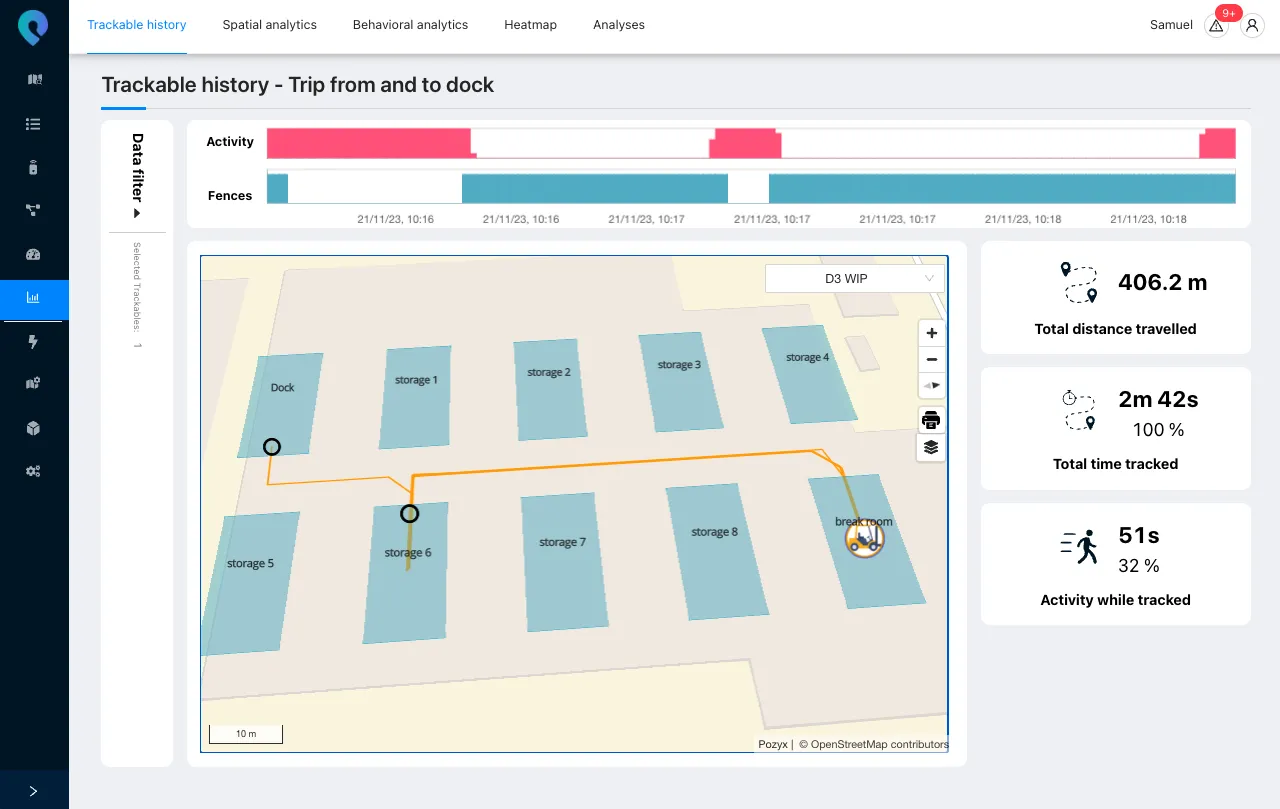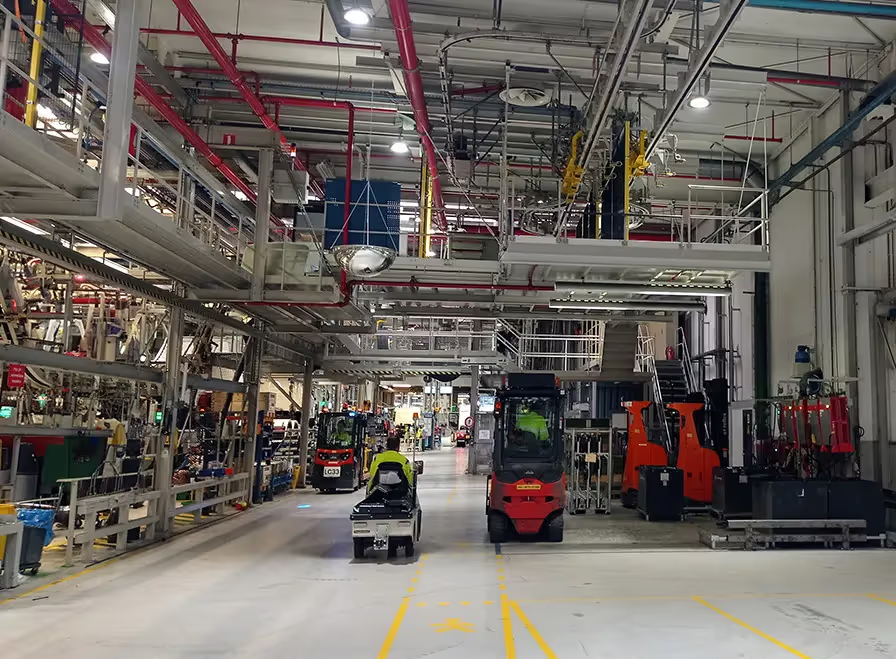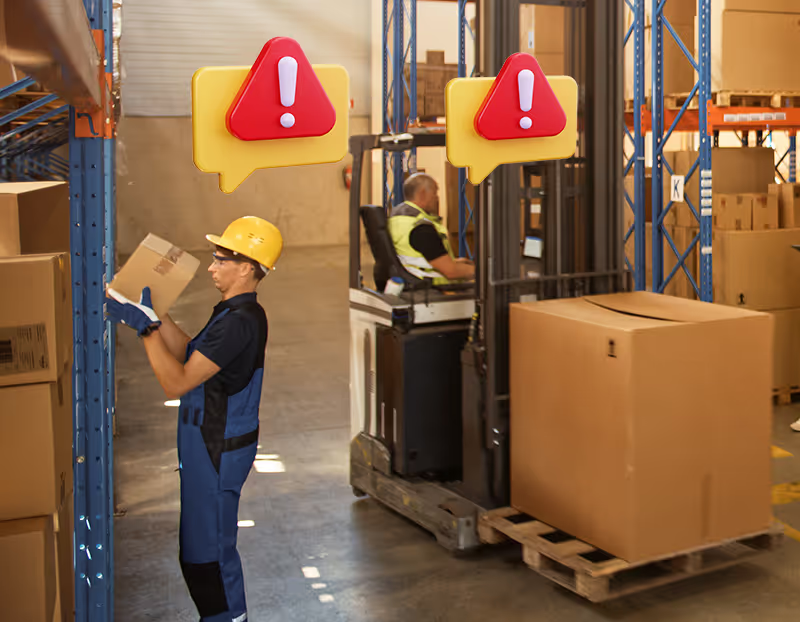Revolutionize Your Warehouse Efficiency with Forklift Tracking
Streamline operations, boost safety, and optimize forklift performance using our advanced UWB RTLS forklift tracking solution.
Experience Real-Time Forklift Tracking
Our cutting-edge forklift tracking solution leverages UWB RTLS technology to transform warehouse operations. By providing real-time visibility of forklift locations, our system helps streamline inventory management, optimize workflows, and boost overall safety.
Discover how our forklift tracking solution can reduce downtime, improve fleet utilization, and drive significant cost savings in manufacturing and logistics environments.
Works with Any Forklift
Pozyx works with all forklift types and brands—no modifications needed. Whether you use pallet trucks, counterbalance forklifts, or AGVs, the system integrates seamlessly across your fleet.
High Accuracy, Built to Scale
Delivering 10–30 cm precision and fast update rates, Pozyx ensures reliable tracking of position, orientation, and fork height. It’s a robust, scalable solution for demanding industrial environments.
Ready-to-Use Software Suite
Pozyx includes a powerful software suite that delivers real-time insights and tools to boost fleet efficiency. It helps you unlock operational value quickly with automations and analytics.
Use-cases of Forklift Tracking
Maximize Fleet Efficiency
Align your fleet size with actual demand and ensure every forklift is fully utilized. Data-driven insights enable smarter scheduling and resource allocation, reducing idle time and unnecessary equipment expenses.
- Improved asset utilization
- Data-driven scheduling and fleet management
- Reduced maintenance and operating costs
- Optimized fleet size to match operational needs
Enhance Inventory Accuracy
Forklift tracking revolutionizes inventory management by automating the process of updating warehouse and production floor locations. Instead of relying on error-prone manual scanning, our UWB RTLS system tracks the forklift’s location, orientation, and fork height to automatically record where pallets are dropped off.
- Ensures drop-off occurs in the designated zone or trailer
- Ensures real-time, error-free inventory updates
- Eliminate manual scanning
Optimize Workflow & Routes
Transform your facility operations by identifying and eliminating inefficient travel paths. With real-time data on forklift movements, our system helps you optimize warehouse layouts and streamline the flow of materials.
- Identifies inefficient travel routes
- Reduces wasted operational time
- Enhances overall workflow efficiency
- Optimizes facility layout for smoother operations

Enhance Workplace Safety
Our UWB RTLS forklift tracking system boosts safety by delivering precise, real-time forklift locations that improve operational awareness and help meet safety standards. Seamlessly extend its capabilities with the Pozyx collision avoidance system for proactive warnings and further accident prevention.
- Real-time speed monitoring and adjustment based on location
- Gain insight on the safety risks in your facility
- Easily extends to collision avoidance solutions
Customer Success Stories
How Does the Forklift Tracking System Work
The Pozyx Forklift Tracking System uses Ultra-Wideband (UWB) technology, where fixed anchors and mobile tags work together to provide precise, real-time location data. Tags mounted on forklifts communicate with anchors installed in the facility to enable accurate tracking and to capture additional sensor data from the forklift.

- Location Tags – Mount a Pozyx UWB positioning tag on each forklift. These tags can be battery-powered or connected directly to the forklift’s power supply.
- Infrastructure – Install anchors on walls or ceilings to receive signals from the tags. Pozyx anchors offer extended range to reduce the number needed and support smart daisy chaining to minimize wiring.
- Software Application – The Pozyx platform is a leading RTLS visibility solution, delivering a range of ready-to-use features and insights straight out of the box.
Curious what this means for your forklift fleet? Pozyx offers a free, no-obligation anchor plan tailored to your use case and facility.
Extend Your Capabilities with Additional Sensors
Enhance your operational efficiency even further by integrating advanced sensors that work seamlessly with our Pozyx RTLS. Discover how these add-ons elevate performance and simplify your workflows.

Forklift Load & Height Sensor
Boost Inventory Accuracy
Mounted directly on the fork, this sensor precisely measures load presence and fork height.
- Automated Drop-Off Verification
- Enhanced Inventory Placement
- Error-Free Updates

Forklift Load Scanner
Eliminate Manual Scanning
Automatically scan barcodes on boxes loaded on pallets, removing the need for manual data entry.
- Faster Loading Processes
- Accurate Item Tracking
- Streamlined Warehouse Operations

Forklift Collision Avoidance Sensor
Maximize Workplace Safety
Combine with RTLS for proactive safety—ensuring real-time proximity alerts and collision prevention.
- Supports Proximity Warnings
- Enhanced Operational Awareness
- Reduced Accident Risks
Optimize Your Fleet with Data-Driven Insights
Turn real-time forklift data into actionable insights with the Pozyx Platform. Our dashboard delivers full visibility of your fleet, helping you optimize operations, boost efficiency, and improve decision-making at every level.
Key features include:
- Real-Time Location & Load Status: See exactly where forklifts are, whether they’re loaded, and track fork height in real time.
- Trip & Utilization Metrics: Monitor active time, idle time, and movement patterns to improve OEE and right-size your fleet.
- Spaghetti Charts & Heatmaps: Visualize forklift routes and traffic intensity to eliminate bottlenecks and redesign workflows.
- Historical Playback: Replay past movements to analyze workflows and resolve incidents.
- Advanced Rule Engine: Trigger alerts and automations based on custom rules (e.g. zone entry, inactivity, load presence).
Whether you manage a single warehouse or multiple sites, Pozyx gives you the insights to optimize performance, increase safety, and reduce downtime—all from one easy-to-use interface.
Maximize Your ROI with Pozyx Forklift Tracking
Investing in Pozyx forklift tracking delivers real, measurable returns. By automating inventory updates, optimizing fleet utilization, and reducing accident-related downtime, our solution helps you save costs and improve productivity. Companies have seen tangible benefits such as reduced labor expenses and enhanced operational efficiency that quickly pay for the system.
- Labor Savings: Cut search and manual data entry time, translating into significant cost reductions.
- Improved Asset Utilization: Optimize fleet size and reduce unnecessary equipment expenses.
- Reduced Downtime: Minimize disruptions from accidents and maintenance delays.
- Enhanced OEE: Boost Overall Equipment Effectiveness with real-time performance insights.
With Pozyx, you not only streamline operations but also unlock a compelling ROI. Experience a smarter, safer warehouse that drives hard benefits and improves your bottom line.
in action











